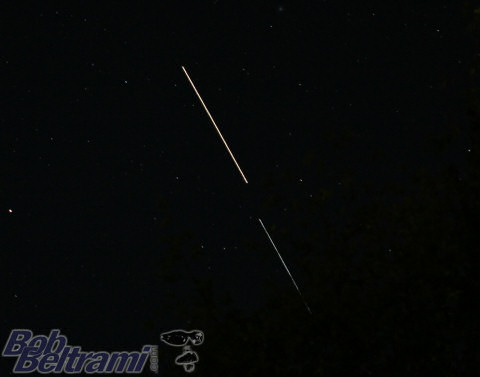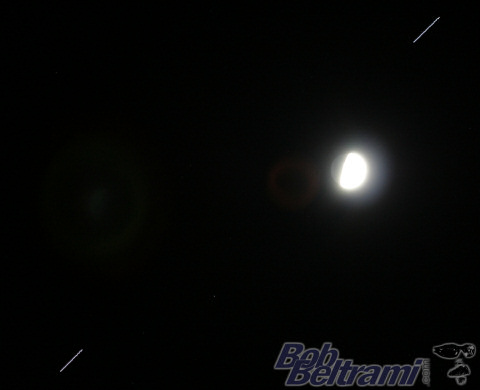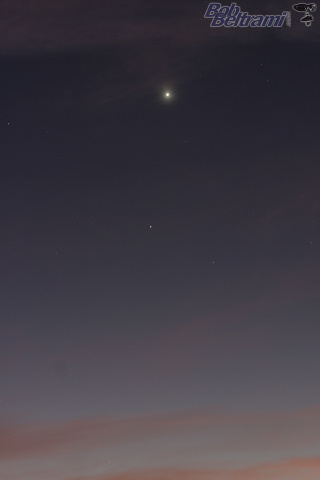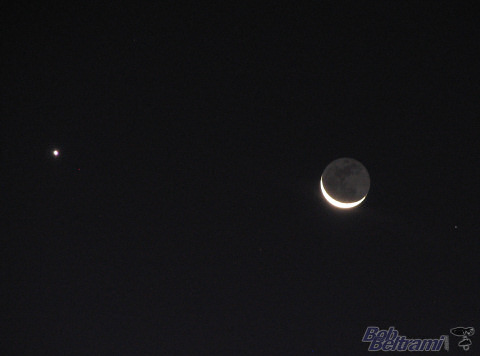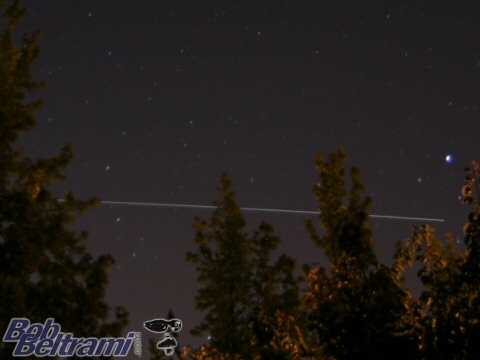Astronomy
Photo Log Book
9/25/09 - ISS Flyover With A Bonus
The International Space Station was scheduled for a flyover on November 25 while docked with the Space Shuttle Atlantis. I was ready to get a few photos as the ISS came over the horizon, when a second object followed a moment later. The shuttle had undocked from the station and the two were slowly drifting apart as the shuttle headed back to Earth. The first shot, left, captured the pair as they came over the horizon - the Shuttle is just coming out of the tree tops. And the second photo caught the pair as they raced past the Moon.
9/17/09 - Venus At Sunrise
With yesterday's crescent so prominent, I was up early again in hopes of catching the last sliver of the moon at sunrise. No such luck.
But the sunrise was beautiful with some clouds just beginning to haze over Venus. I managed to sneak a shot between wisps of clouds, and before dawn brightened the scene.
9/16/09 - Moonrise With Venus
The crescent moon rose with Venus on Wednesday. Before the sun started lighting the sky I got the shot on the right.
5/29/09 - International Space Station Fly Over
A 42-second exposure taken on May 24th at approx. 9:07 P.M. caught the International Space Station as it flew over the west coast headed southeast (left to right). The camera is on a static tripod facing northeast, pointed relatively low on the horizon. The bright star on the right is Vega. Hover over the thumbnail for a preview; click to open a larger version (1024x768 - 65kb).
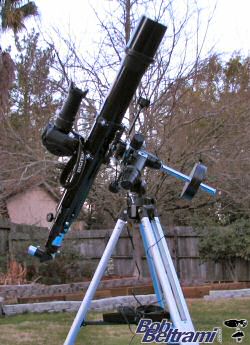
Equipment:
- Celestron C4-R Advanced Series Achromatic Refractor Telescope (#21016)
- 102mm/4" Diameter Objective Lens
- 1000mm Focal Length
- f/10 Focal Ratio
- Celestron CG4 German Equatorial Mount w/ Two-axis Clock Drive and Tripod
- Lenses:
- 9mm
- 12.5mm
- 20mm
- 32mm
- 2x Barlow
- Canon 10D Digital Camera
- BG-ED3 Battery Grip
- TC-80N3 Timer/Remote Controller
- Tamron 28-300 Zoom
- Tamron 19-33 Wide Angle
Links
Log Book Archive
12/25/07
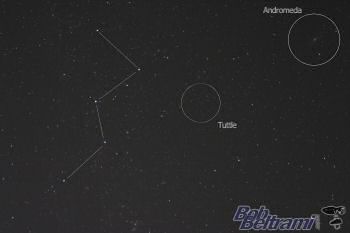
M31/Andromeda
After several weeks of rainy weather and overcast skies, Christmas Eve 2007 was crisp and clear, providing the opportunity to pull out the gear and search the night sky. There was plenty to see: In addition to Comet 17p/Holmes, 8p/Tuttle is in view and Mars is in opposition and within a few degrees of the full moon.
When I started, the moon was just rising, so I chose to start in Cassiopeia looking for Tuttle. I snapped a 30 second wide-field exposure (right) and waited for the preview. Even in the tiny camera display I could see Cassiopeia's familiar shape. But my eye was immediately drawn to a fuzzy area in the upper right corner. Too far south to be Tuttle, my curiosity got the better of me and I took the memory card inside to have a clear look at the shot on the computer. What I found was more interesting than I'd thought: Cassiopeia just left of center, Tuttle almost square in the middle (but only barely visible) and the Andromeda Galaxy in the right top corner.
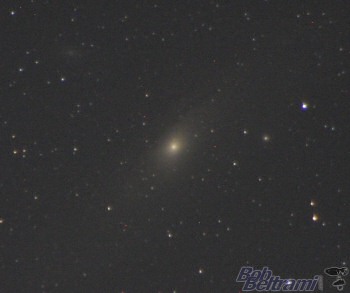
It was my first look at Andromeda and I'd captured it by accident so my interest shifted away from Tuttle. I repositioned the scope and zoomed in for a closer shot. The result is what you see here, tho the right. Andromeda itself is clearly visible and even the separation of the spiral arms can be discerned. Also, the companion galaxies, M110 and M32 are visible.
Image information:
- Aperture f/5.6
- 300mm Focal Length
- 80 Second Exposure
- ISO 800
M45/Pleiades
With Tuttle relatively dim and the Moon and Mars too low on the horizon I decided to get a close shot of an easier target, knowing that I have a lot of practice to do. So I chose to go after the Pleiades because it is plainly visible and makes a good target.
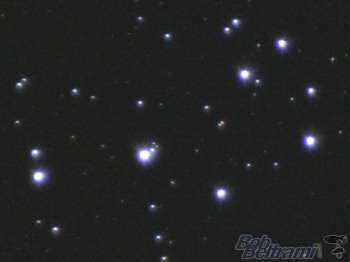
It didn't take long to find and capture. After several different combinations of settings on the camera, I managed the shot here.
Image information:
- Aperture f/5.6
- 238mm Focal Length
- 30 Second Exposure
- ISO 800
11/21/07 - Comet 17p/Holmes
My first attempt at astrophotography was this shot of Comet 17P/Holmes above Alpha Persei (Mirfak) in Perseus, on November 21, 2007. Other than cropping and resizing, the photo is unedited.
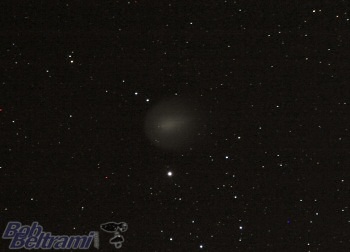
While this result is a good start it shows I've a lot of room for improvement! It was my first time setting polar alignment and using the clock drive, so there is slight drift. The focus isn't quite right. I need more experience to be able to optimize camera settings for the best results. Adding to the difficulty of achieveing a decent photo, the moon was past 90% of full and relatively close. The full size version of the photo is available.
Image information:
- Aperture f/6.7
- 130mm Focal Length
- 133 Second Exposure
- ISO 100

